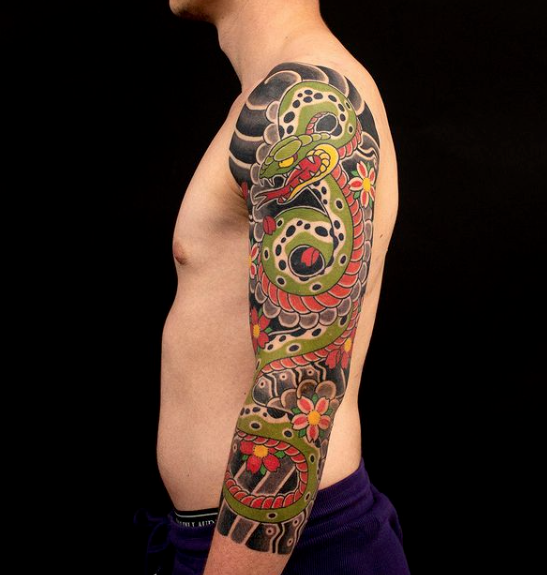BLOG
Floral motifs in Traditional Japanese Tattooing - Part 1 Cherry blossoms
Traditional Japanese tattooing is typically created with three main elements, Background or “Gakubori”, the main subject matter, and an often overlooked complimentary floral element.
Floral elements are an important element of Traditional Japanese tattooing. They have a variety of meanings in Japanese culture, and when paired correctly with the right subject matter, they can create a harmonious tattoo rich with history and tradition.
Cherry blossoms or “sakura” represent beauty and the fragility of life in Japanese culture. They are a spring blossom that bloom in abundance throughout Japan and are the centre of their festival culture. Their blossoming period is quite short, and they are susceptible to wind and rain. The flower falls off the tree in full bloom, each perfect and bright petal falling to the ground. The use of this flower in Japanese art or tattoos symbolise the transience of life, and have been often used as a metaphor for a warrior killed early in life. This flower can be paired with most subject matter, but is particularly synonymous with Koi and the traditional folk tale of the koi travelling up a wasteful to become a dragon. Typically signifying triumph over adversity.
Cherry blossoms with Koi and water
Cherry blossoms with snake (hebi)
Interesting facts about Japanese Tattoos
Did you know that in some Japanese bath houses, anyone with a tattoo is refused entry? Seems a bit harsh, even for a conservative country like Japan, but the reason goes back hundreds of years…
Irezumi is the name given to tattooing in Japan, and refers to many different forms of traditional Japanese tattoos, or modern forms inspired or derived from them. Just to confuse things, the word can be written AND spoken in several different ways, and also translate into several different words, although the most common is literally “insert ink”.
Japanese tattoos date back thousands of years, but their meaning and role in society fluctuates with different time periods. It was around the Kofun period (300-600 AD) that tattoos began to take on negative associations. Criminals were tattooed as a form of punishment, so others would know they had committed a crime.
Tattoo fads came and went over the next thousand years, but the stigma lingered, and at the beginning of the Meiji period, tattoos were outlawed altogether. Of course, when you outlaw anything, you only drive it underground, so tattoos were now officially the cool thing to have, and as Japan opened up to the West, many came to seek the skills of traditional Japanese Tattoo Artists.
The connotations with criminality still persisted, with many associating tattoos with the Yakuza, Japan’s infamous mafia. This gave tattoos in Japan a stigma which is still seen today in the bath houses and other Japanese businesses. Japanese tattoos were legalised again after the war, but even today, a tattoo studio is hard to find. It is estimated there are around 300 tattoo artists in Japan; an incredibly small percentage considering its 127 million population.
If you’re interested in Japanese tattoos, then come see Tom at Sunset Studios. He's spent years studying Japanese tattoos and is always up for a chat about any design ideas you have.
Japanese Tattoos
Did you know that in some Japanese bath houses, anyone with a tattoo is refused entry? Seems a bit harsh, even for a conservative country like Japan, but the reason goes back hundreds of years…
Irezumi is the name given to tattooing in Japan, and refers to many different forms of traditional Japanese tattoos, or modern forms inspired or derived from these. Just to confuse things, the word can be written AND spoken in several different ways, and also translate into several different words, although the most common is literally “insert ink”.
Japanese tattoos date back thousands of years, but their meaning and role in society fluctuates with different time periods. It was around the Kofun period (300-600 AD) that tattoos began to take on negative associations. Criminals were tattooed as a form of punishment, so others would know they had committed a crime.
Tattoo fads came and went over the next thousand years, but the stigma lingered, and at the beginning of the Meiji period, tattoos were outlawed altogether. Of course, when you outlaw anything, you only drive it underground, so tattoos were now officially the cool thing to have, and as Japan opened up to the West, many came to seek the skills of traditional Japanese Tattoo Artists.
The connotations with criminality still persisted, with many associating tattoos with the Yakuza, Japan’s infamous mafia. This gave tattoos in Japan a stigma which is still seen today in the bath houses and other Japanese businesses. Japanese tattoos were legalised again after the war, but even today, a tattoo studio is hard to find. It is estimated there are around 300 tattoo artists in Japan; an incredibly small percentage considering its 127 million population.
If you’re interested in Japanese tattoos, then come see Tom at Sunset Studios. He's spent years studying Japanese tattoos and is always up for a chat about any design ideas you have.




